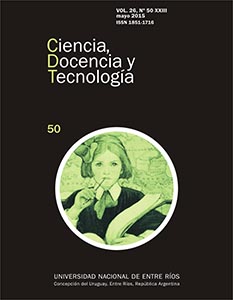Abstract
The learning process that took place during an educational project with homeless children whose purpose was to provide tools to access literacy through the arts (visual art, music, drama, oral narrative) is here analyzed. Our analytical perspective was framed by the concept of learning in interaction. We interpret children´s production of narratives as a complex interweaving of resources which become available in interaction (with others, with texts, and with the arts) and provide opportunities and challenges for literacy learning processes, in particular learning how to narrate. We end by highlighting recommendations for other groups who may want to conduct similar educational projects.
References
ARENDT, H. (1995). Labor, trabajo, acción. (pp. 89-107). En: ARENDT, H. De la historia a la acción. Barcelona: Paidós.
AULAGNIER, P. (2003). El aprendiz de historiador y el maestro-brujo. Buenos Aires: Amorrortu.
ÁVILA, H. y PALLERES, G. (2014). La calle no es un lugar para vivir. Buenos Aires: Paidós.
BLEGER, J. (2007). Temas de psicología. Entrevista y grupos de aprendizaje. Buenos Aires: Nueva Visión.
BARTON, D. & HAMILTON, M. (1998). Local literacies. Reading and Writting in One Community. London: Routledge.
BRAIDOTTI, R. (2009). Transposiciones. Sobre la ética nómada. Barcelona: Editorial Gedisa.
CASTORIADIS, C. (1997). La democracia como procedimiento y como régimen. (pp. 267-291). En CASTORIADIS, C. El Avance de la Insignificancia. Las encrucijadas del laberinto IV. Buenos Aires: Eudeba.
DOSSO, P. (2013). Variaciones de la forma escolar. Tesis de Maestría. Argentina. Facultad de Filosofía y Letras, Universidad de Buenos Aires.
FREIRE, P. (1983). The importance of the act of Reading, en: Journal of education, Vol. 165, N°1: 5-11.
FREIRE, P. (2001). Política y educación. Buenos Aires: Siglo XXI Editores.
FREIRE, P. (2008). Pedagogía de la autonomía. Buenos Aires: Siglo XXI Editores.
FREIRE, P. y MACEDO, D. (1987). Literacy: Reading the Word and the World. Massachusetts: Bergin and Garvey.
GEE, P. (1986). Oralidad y Literacidad : de El pensamiento Salvaje a Ways with Words. (pp. 23-55). En : ZAVALA, V., NIÑO-MURCIA, M. y AMES, P. (Eds.). Escritura y Sociedad. Nuevas Perspectivas teóricas y Etnográficas. Perú : Red para el Desarrollo de las Ciencias Sociales del Perú.
GINZBURG, C. (1980). Signes, traces, pistes: racines d´un paradigme d´indice, en: Le Debat, 6: 3-44.
HERAS, A. I. (1993). The Construction of Understanding in a Sixth-Grade Bilingual Classroom. Linguistic and Education, en: An International Research Journal, Vol, 5, N°3 y 4: 275-299.
HERAS A. I. (1995). Living Bilingual, Interacting in Two Languages: An Ethnographic and Sociolinguistic Study of a Fourth Grade Bilingual Classroom. Tesis doctoral. USA. Universidad de California, Santa Bárbara, California.
HERAS (1999). Taking Action with Family and Community Members: Critical Pedagogy as a Framework for Educational Change, en: Advances in Confluent Education, Vol. 2: 73-107.
HERAS, A. I., BERGESIO, L. y BURIN, D. (2004). “Trabajo etnográfico, sociolinguística interaccional y comunicación visual en la generación y análisis de datos en lenguajes diversos”. IV Jornadas de Etnografía, CAS, IDES. Agosto, Buenos Aires, Argentina.
HERAS, A. I. y GREEN, J. (2010). Identidades y políticas públicas educativas. Las consecuencias de cambiar de una comunidad bilingüe a inglés como única lengua de instrucción. (pp. 154-195). En LÓPEZ BONILLA, G y PÉREZ FRAGOSO, C, Discursos e identidades en contextos de cambio educativo. México: Plaza y Valdés.
HERAS MONNER SANS, A. I. (2011). Dispositivos de aprendizaje en autogestión: sus relaciones con el proyecto de autonomía, en: Intersecciones en Comunicación, (5): 31-64.
HERAS, A. I. y MIANO, A. (2012). El lenguaje audiovisual en la investigación social y la comunicación pública del conocimiento, en: Revista Ciencia, Público y Sociedad N°1: 18-40.
HERAS, A. I. y BURIN, D. (2013). “Experiencias de incidencia en política pública de organizaciones autogestionadas: desde la autonomía como proyecto y hacia la democracia como régimen de sentido”. X RAM, Reunión de Antropología del MERCOSUR. Julio, Córdoba, Argentina.
MIANO, A. (2013). “Detonando la burocracia. Estrategias desarrolladas por grupos autogestionados en las interacciones establecidas con el Estado”. X RAM, Reunión de Antropología del MERCOSUR. Julio, Córdoba, Argentina.
MONTES, G. (2007). La gran ocasión: la escuela como sociedad de lectura. Plan Nacional de Lectura. Ministerio de Educación, Ciencia y Tecnología: Argentina.
PALLERES, G. (2004). Conjugando el presente. Personas sin hogar en la Ciudad de Buenos Aires. Buenos Aires: Sociedad Argentina de Antropología.
RICOEUR, P. (1995). Tiempo y narración. México: Siglo XXI Editores.
SPRADLEY, J. (1980). Participant observation. New York: Holt, Rinehart and Winston.
STREET, B. V. (1984). Literacy in theory and practice. Cambridge: Cambridge University Press.
ZAVALA, V. (2002). Desencuentros con la escritura. Perú: Red para el Desarrollo de las Ciencias Sociales del Perú.
The authors retain the copyright and grant the journal the right to be the first publication of the work, as well as licensing it under a Creative Commons Attribution License that allows others to share the work with an acknowledgment of the authorship of the work and publication initial in this magazine. All content is published under the Creative Commons 4.0 international license: Attribution-Non-Commercial-Share Alike.

